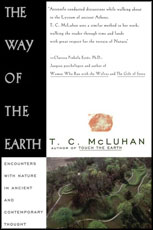"Today the sacred sites continue to offer a lifeline to Aboriginal society. Through the re-acquisition of ancestral lands, the sites are gradually being returned to in greater numbers and their sleeping energies are being re-awakened through the renewed observance and practice of ritual, providing strength, guidance and solace to Aboriginal people. . . .
"The Aboriginal landscape consists of a network of traditional pathways — an intricate and sacred criss-crossing of mythical tracks (Dreaming Tracks) — marked by the passages of ancestral beings and punctuated by their legacy of a multitude of holy sites. The Aboriginal people today know these ancestral routes, and when they move across them they are both animating them and honoring their spiritual sources. Within the context of our own cash economy, 'most sacred sites,' writes Fred Myers in his study of Pintupi life, 'are said, therefore, to be "gold." ' The active custodianship of these sites is essential to the fertility of the universe. For this reason, sacred sites like the extraordinary Ayers Rock — which has developed in recent years into a tourist attraction — have become a source of great anxiety to the senior clan elders and 'owners' (male and female) who care for and protect these hallowed locations, the spirit source from which they came and to which they will return. The maintenance and nurturing of the sites through the vigilant performance of ceremonies and rituals is vital to the health of the tribe and the planet. Big Bill Neidjie, Bunitj elder from the East Alligator River of Arnhem Land, speaks about it this way:
" 'Our story is in the land . . .
It is written in those sacred places.
My children will look after those places,
that's the law.
Dreaming place . . .
you can't change it.
No matter who you are.
No matter you rich man,
no matter you king.
You can't change it. . . .
Rock stays
Earth stays
I die and put my bones in cave or earth
Soon my bones become earth . . .
All the same
My spirit has gone back to my country . . .
My mother.' "
